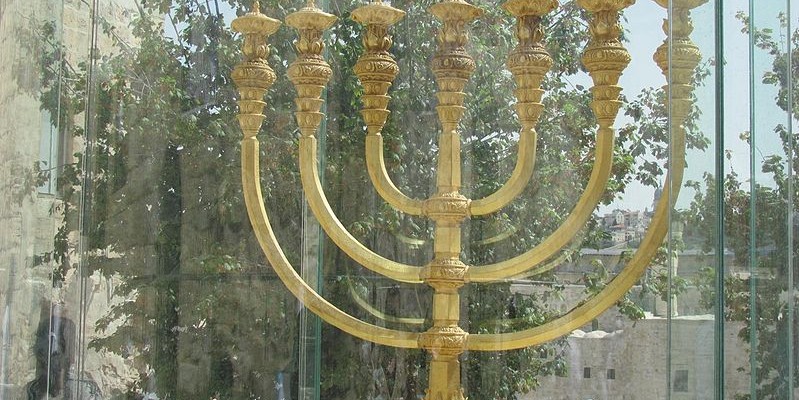The menorah, a seven-branched candelabrum, is the oldest symbol of the Jewish religion, and a variation of it is used for the observance of Chanukah – the Festival of Lights.
During Chanukah, the Festival of Lights, Jews worldwide will light the chanukiah, a modern-Hebrew word describing the candelabrum with nine branches that resembles a menorah and is used on this festival.
One branch is lit on the first night, and another is added each subsequent night until the eighth, when the menorah becomes fully lit. The ninth branch in the center is used for the flame that lights the main branches.
The original menorah stood in the First and Second Temples in Jerusalem. The priests would light it in the sanctuary each day, following detailed procedure as instructed in the Bible.
Chanukah celebrates two miracles. First was the 2nd-century BCE victory of a small band of Jewish fighters against the powerful Syrian-Greek army. Second, upon the priests’ return to the Holy Temple to light the menorah, a tiny amount of oil that should have lasted no more than a day in fact sufficed for eight days, thus enabling the Jews to produce more.
The Talmud states that it is forbidden to use a seven-branched menorah outside of the Temple, which is why the modern-day chanukiah is slightly different.
As explained by the Temple Institute, a non-profit educational and religious organization, the Holy Temple that King Solomon had built largely resembled the Tabernacle “in its basic layout, albeit on a much larger scale.”
(The Tabernacle, according to the Hebrew Bible, was the portable dwelling place for the Divine presence from the time of the Exodus from Egypt through the conquering of the land of Canaan.)
One very significant difference was the fact that Solomon had added another 10 menorahs, which stood in the sanctuary.
It has not been ascertained whether or not the menorah that was taken to Rome following the destruction of the Second Temple in the year 70 AD was in fact the main menorah. What is definite, though, is that a menorah from the Temple did reach Rome.
On the Arch of Titus, which was constructed in the year 82 AD in Rome in commemoration of the siege of Jerusalem, a bas-relief depicts the arrival of sacred Temple vessels, including a menorah. In fact, according to recent scientific investigation by international scholars, headed by Yeshiva University’s Center for Israel Studies, the original color of the painted menorah was indeed gold, as was the Temple menorah.
“We are told in the book of Kings that King Solomon had eleven menorahs made, which stood in the sanctuary,” states Temple Institute literature. “While we only know of one Menorah which stood in the Sanctuary of the second Holy Temple, we know for a certainty that there were a number of spare Menorahs on stand-by in case the sanctuary menorah became impure or needed repair. Therefore, it is the opinion of many Torah sages that the menorah taken to Rome and depicted on the Arch of Titus was one of the spare menorahs kept in the Temple warehouse and not the active duty menorah which would have been standing in the sanctuary.”
Many wonder what could have happened to the central menorah.
“There are passages in the Talmud which testify that, as the Roman siege of Jerusalem sealed the fate of the city, the people of Jerusalem understood that destruction of the Holy Temple would inevitably follow. They therefore decided to place each of the sacred vessels in hiding,” the Institute states.
The menorah has remained the ultimate Jewish icon throughout history. The lamp standing in contemporary synagogues, known as the Ner Tamid (Hebrew for Eternal Flame), symbolizes the menorah. It is the emblem on the coat of arms of the State of Israel, and a large menorah greets travelers arriving at Israel’s Ben Gurion Airport.

Send 'Warm Winter' Care Packages to Israeli Soldiers - They are Cold!
We are honored to thank the young men and women of the IDF who risk their lives every day to defend the citizens of Israel.
Join us in sending winter care packages and personal notes of support to Israeli soldiers who are out in the cold all day.
Warm up a soldier's heart with essential winter wear including fleece jackets. Keep an entire unit warm by ordering 10 packages... The soldiers truly appreciate your love and concern!

